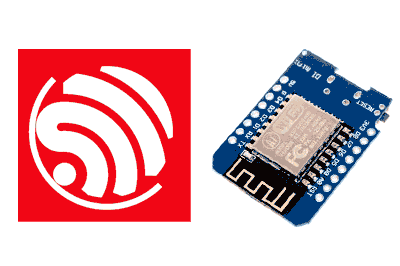In the previous entry of the ESP8266 section, we saw the NodeMCU. This time we are going to look at what is surely my favorite development board based on the popular ESP8266 SoC, the fantastic Wemos D1 Mini.
The Wemos D1 Mini board is the smaller version of its bigger sister, the Wemos D1, which we will see in a future entry. With dimensions of 34.2mm x 25.6mm and a weight of 3g, it is one of the smallest boards based on the ESP8266.
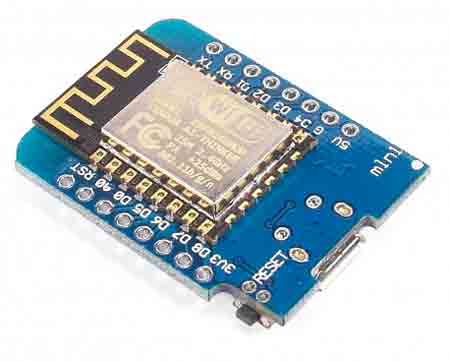
The Wemos D1 Mini is only slightly larger than using an ESP12 module directly and offers many advantages, such as incorporating a Micro SD port and serial converter, a voltage regulator that allows it to be powered at 5V, and terminals to connect our devices.
In addition, the Wemos D1 Mini has the philosophy of allowing functionality to be expanded through the connection of Shields. There is a wide variety of Shields available, such as motor controllers, relay modules, OLED displays, temperature or humidity sensors.
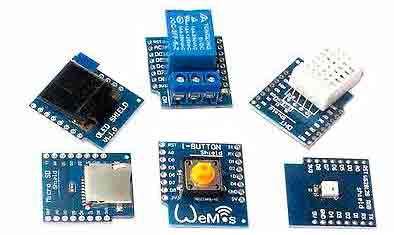
On the downside, the biggest disadvantage of the Wemos D1 Mini is that it has fewer available pins. It only exposes 11 GPIO pins compared to the 17 available on the ESP12 or the NodeMCU, although in most projects this is not a major issue.
Features of the Wemos D1 Mini
As we said, the Wemos D1 Mini is based on the ESP12E, so its features come directly from it. In summary, these are some of the main features:
Speed: 80MHz/160MHz
Flash: 4M bytes
Operating voltage: 3.3V
Digital inputs and outputs: 11, all (except D0) with PWM, interrupts, and I2C
Analog inputs: 1 (Max. 3.2V)
Micro-USB connector
For detailed specifications, see the entry about the ESP12E
Price
The price is one of the strong points of the Wemos D1 Mini. We can find it for about 2-2.20€. Therefore, it is even more affordable than a NodeMCU and only slightly more expensive than buying the module alone (to which we would have to add components, etc.).
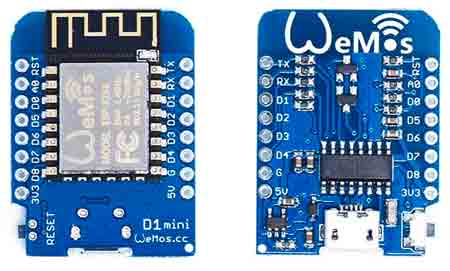
That is, the Wemos D1 Mini has a truly unbeatable price.
It is worth noting that there is a version, the Wemos D1 Mini Pro (next image, on the right), which increases the memory to 16MB, and costs quite a bit more, around 4-5€.
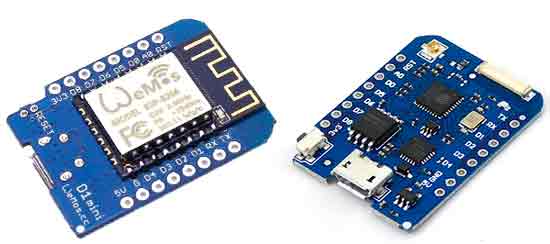
Be careful if you try to buy a Wemos D1 Mini Pro; verify that it has 16Mb and not 4Mb, because some sellers sell a physically identical model but with 4Mb. That is, the same as the “non-Pro”.
Pinout of the Wemos D1 Mini
As we are getting used to, one of the biggest headaches when working with development boards based on the ESP8266 is the lack of consensus in designating the pins. Therefore, it is even more important to have a good pinout diagram of the board nearby.
Here you have the Pinout of the Wemos D1 Mini:
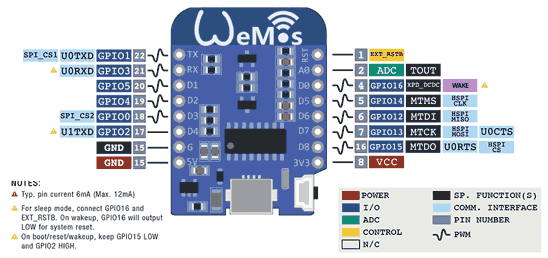
And here is a summary table of the pins and their main functions.
| Pin | ESP-8266 Pin | Function |
|---|---|---|
| TX | TXD | TXD |
| RX | RXD | RXD |
| A0 | A0 | Analog input (max 3.2V) |
| D0 | GPIO16 | IO |
| D1 | GPIO5 | IO, PWM, Interrupt, I2C, SCL |
| D2 | GPIO4 | IO, PWM, Interrupt, I2C, SDA |
| D3 | GPIO0 | IO 10k Pull-up, PWM, Interrupt, I2C |
| D4 | GPIO2 | IO 10k Pull-up, PWM, Interrupt, I2C, BUILTIN_LED |
| D5 | GPIO14 | IO, PWM, Interrupt, I2C, SCK |
| D6 | GPIO12 | IO, PWM, Interrupt, I2C,, MISO |
| D7 | GPIO13 | IO, PWM, Interrupt, I2C,, MOSI |
| D8 | GPIO15 | IO 10k Pull-down, PWM, Interrupt, I2C,, SS |
| G | GND | Ground |
| 5V | - | 5V |
| 3V3 | 3.3V | 3.3V |
| RST | RST | Reset |
Programming the Wemos D1 Mini
Programming the Wemos D1 Mini from the Arduino environment is easy and straightforward, just like for the other ESP8266 boards. The process is identical to what we saw in How to program ESP8266 with the Arduino IDE, so if you have any doubts, visit that entry.
We just need to make sure to select the board “Wemos D1 R2 or Mini”:
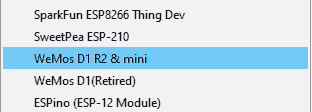
This concludes the tutorial on this excellent board based on the ESP8266. As I said, it is one of my favorite development boards. With the price it has, we can afford to integrate it into any project.
